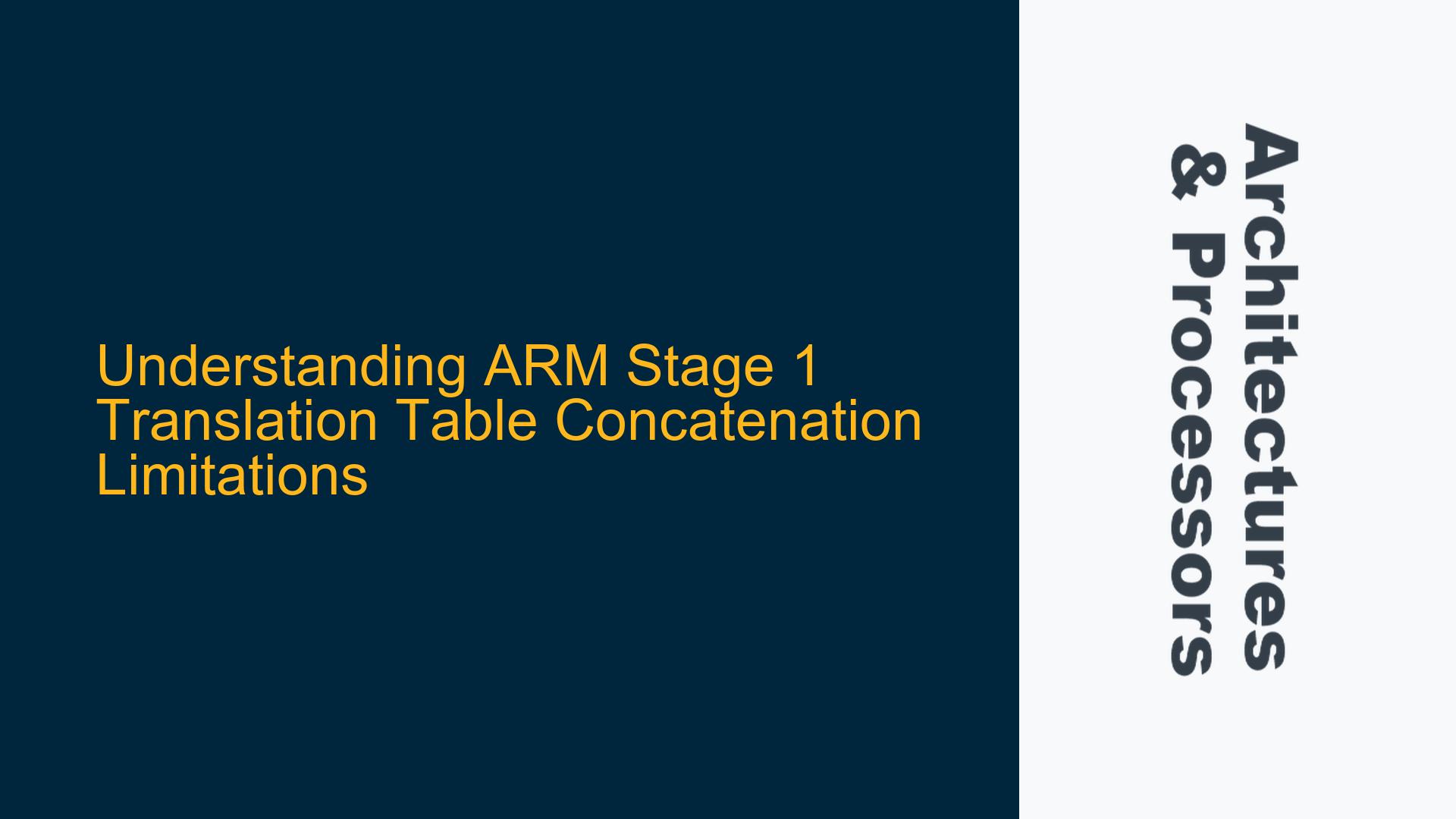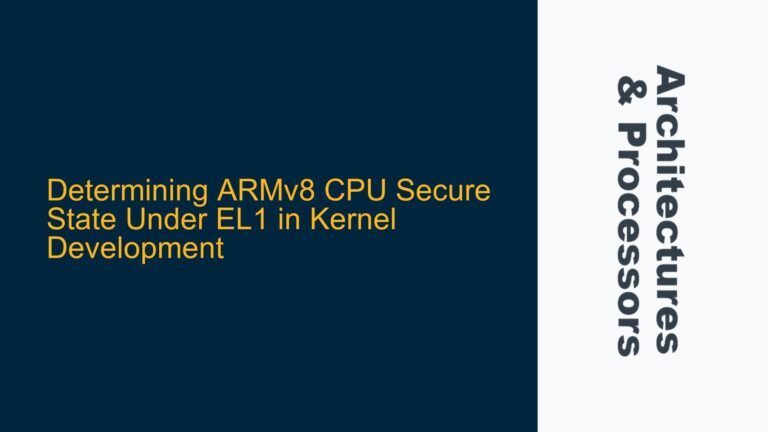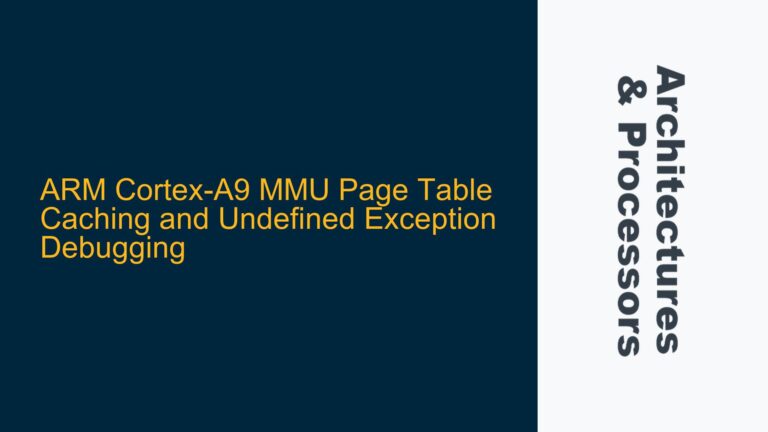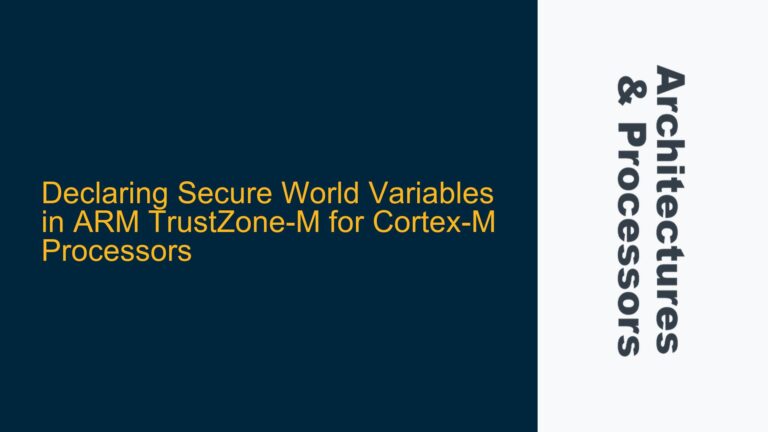ARM Stage 1 Virtual Address Translation and Concatenation Constraints
In ARM architectures, virtual address (VA) translation is a critical process that enables the operating system to manage memory efficiently. The translation process is typically divided into two stages: Stage 1 and Stage 2. Stage 1 is responsible for translating virtual addresses to intermediate physical addresses (IPAs), while Stage 2 translates these IPAs to physical addresses (PAs). One of the key differences between these stages is the support for translation table concatenation. While Stage 2 allows for the concatenation of translation tables to optimize performance by reducing the number of translation levels, Stage 1 does not support this feature. This limitation has significant implications for system performance and software design, particularly in the context of operating systems and hypervisors.
The absence of concatenation in Stage 1 translation tables is not arbitrary but is rooted in the architectural design choices made by ARM. These choices are influenced by the need to support a wide range of use cases, particularly those involving general-purpose operating systems. The complexity and variability of these use cases make it challenging to implement concatenation in Stage 1 without compromising flexibility or introducing additional overhead. Furthermore, the hardware mechanisms required to support concatenation in Stage 1 would need to be significantly more complex, given the diverse requirements of different operating systems and applications.
To understand why concatenation is not supported in Stage 1, it is essential to delve into the specifics of how translation tables are structured and managed in ARM architectures. Translation tables in ARM are typically organized in a hierarchical manner, with each level of the hierarchy corresponding to a specific granularity of memory mapping. In Stage 2, concatenation allows multiple translation tables to be combined into a single, larger table, effectively reducing the number of levels required for address translation. This can lead to performance improvements by minimizing the number of memory accesses needed during the translation process. However, in Stage 1, the translation tables are managed by the operating system, which must handle a wide variety of memory mapping scenarios, including those involving multiple processes, shared memory regions, and dynamic memory allocation.
The lack of concatenation support in Stage 1 is also influenced by the need to maintain compatibility with existing software and hardware implementations. Introducing concatenation in Stage 1 would require significant changes to the way translation tables are managed by the operating system, potentially breaking existing software that relies on the current behavior. Additionally, the hardware required to support concatenation in Stage 1 would need to be more complex, as it would need to handle a wider range of translation table configurations and memory mapping scenarios. This increased complexity could lead to higher power consumption and reduced performance, particularly in systems with limited resources.
Memory Management Complexity and Use Case Variability
The primary reason for the absence of concatenation support in Stage 1 translation tables is the complexity of memory management in general-purpose operating systems. Operating systems are responsible for managing memory for a wide range of applications, each with its own unique memory requirements. This includes managing memory for multiple processes, handling shared memory regions, and dynamically allocating and deallocating memory as needed. The variability and complexity of these use cases make it difficult to implement concatenation in Stage 1 without introducing significant overhead or compromising flexibility.
In Stage 2, the translation tables are typically managed by a hypervisor, which has a more limited and well-defined set of responsibilities compared to an operating system. The hypervisor is primarily concerned with managing memory for virtual machines, which have relatively straightforward memory mapping requirements. This allows the hypervisor to take advantage of concatenation to optimize performance by reducing the number of translation levels. However, in Stage 1, the operating system must handle a much wider range of memory mapping scenarios, making it difficult to implement concatenation without introducing additional complexity.
Another factor that contributes to the lack of concatenation support in Stage 1 is the need to maintain compatibility with existing software and hardware implementations. Introducing concatenation in Stage 1 would require significant changes to the way translation tables are managed by the operating system, potentially breaking existing software that relies on the current behavior. Additionally, the hardware required to support concatenation in Stage 1 would need to be more complex, as it would need to handle a wider range of translation table configurations and memory mapping scenarios. This increased complexity could lead to higher power consumption and reduced performance, particularly in systems with limited resources.
The variability of use cases in Stage 1 also makes it challenging to implement concatenation in a way that provides consistent performance benefits across different applications. In some cases, concatenation could lead to performance improvements by reducing the number of translation levels. However, in other cases, it could introduce additional overhead, particularly if the operating system needs to frequently modify the translation tables to accommodate dynamic memory allocation or other changes in memory mapping requirements. This variability makes it difficult to justify the additional complexity and overhead required to support concatenation in Stage 1.
Implementing Efficient Memory Management Without Stage 1 Concatenation
Given the constraints and challenges associated with implementing concatenation in Stage 1 translation tables, it is important to explore alternative approaches to optimizing memory management and address translation performance. One such approach is to focus on optimizing the translation table walk process, which is the process of traversing the translation tables to translate a virtual address to a physical address. By reducing the number of levels in the translation table hierarchy, it is possible to minimize the number of memory accesses required during the translation process, thereby improving performance.
One way to achieve this is by using larger page sizes, which can reduce the number of levels required in the translation table hierarchy. For example, using 2MB or 1GB pages instead of 4KB pages can significantly reduce the number of translation levels, leading to fewer memory accesses and improved performance. However, this approach must be balanced against the need to maintain fine-grained memory management, particularly in systems with limited memory resources or those that require precise control over memory allocation.
Another approach to optimizing memory management without concatenation is to use hardware features such as translation lookaside buffers (TLBs) and caches to reduce the overhead of the translation table walk process. TLBs are small, high-speed caches that store recently used translation table entries, allowing the processor to quickly translate virtual addresses to physical addresses without needing to traverse the entire translation table hierarchy. By optimizing the use of TLBs and caches, it is possible to reduce the overhead of the translation process and improve overall system performance.
In addition to hardware optimizations, software techniques can also be used to improve memory management and address translation performance. For example, operating systems can use techniques such as memory pooling, which involves pre-allocating large blocks of memory and managing them internally, to reduce the overhead of dynamic memory allocation. Similarly, operating systems can use techniques such as memory compaction, which involves rearranging memory allocations to reduce fragmentation, to improve memory utilization and reduce the overhead of memory management.
Finally, it is important to consider the impact of memory management on overall system performance, particularly in systems with limited resources. In such systems, the overhead of memory management can have a significant impact on performance, making it essential to carefully balance the trade-offs between memory management complexity and performance. By focusing on optimizing the translation table walk process, using hardware features such as TLBs and caches, and employing software techniques such as memory pooling and compaction, it is possible to achieve efficient memory management without the need for concatenation in Stage 1 translation tables.
In conclusion, the absence of concatenation support in Stage 1 translation tables is a deliberate design choice that reflects the complexity and variability of memory management in general-purpose operating systems. While concatenation can provide performance benefits in Stage 2, the challenges associated with implementing it in Stage 1 make it difficult to justify the additional complexity and overhead. By focusing on alternative approaches to optimizing memory management and address translation performance, it is possible to achieve efficient memory management without the need for concatenation in Stage 1.






